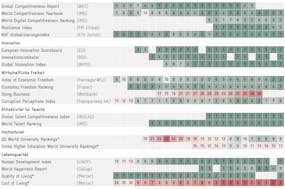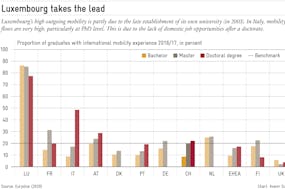Since the launch of ChatGPT at the latest, artificial intelligence has become part of everyday life for the general public. In a survey of computer users, 61% of respondents stated that they use the technology for their work (Deloitte 2023). In the first part of this blog series, we examined the impact of AI on different professional groups in Switzerland. We differentiated between four types of professional groups: those who benefit from AI, those who are favored by it, those who are only slightly affected by it and finally those whose position is endangered by AI.
A degree does not protect against structural change
It seems obvious that the benefits of AI increase with the level of education. According to our estimates, around half of people with a university degree are also among the beneficiaries, 68% including the beneficiaries. However, the probability that AI will have a supportive effect is still 50% for those with higher professional qualifications. On the other hand, the majority of those in employment whose highest qualification is compulsory schooling are hardly affected by AI.
However, the correlation between educational attainment and “AI advantage” is not linear: on the one hand, there are also low-skilled workers who benefit from AI. On the other hand, a high level of formal education alone does not provide complete protection against (potential) competition from AI: one in four employees with a university degree and almost one in three with a higher vocational qualification tend to face competition from AI.

As there is a correlation between educational attainment and income in the labor market, those who already earn above-average wages are likely to benefit more from AI. At CHF 52 per hour, the median income of those “benefiting” from AI is significantly higher than the overall average of CHF 38 per hour. In contrast, the median hourly wage of “less affected” employees, the majority of whom have only a low level of education, is around CHF 30.
The positive correlation between the professional AI advantage and the wage levels is also evident when all individuals are divided into four wage categories (see table below): Over half of those in employment in the highest wage bracket are among the beneficiaries and beneficiaries. In contrast, 53 percent of those in the lowest wage bracket work in occupations that are hardly affected by AI. However, there is one thing to bear in mind: Like higher education, higher wage does not always protect against AI competition. More than a third of those in the two highest wage brackets are potentially in a competitive relationship with AI.
Gender is more relevant than age
While the level of education attained does play a role in the potential for AI use, age appears to be less relevant. Older employees between the ages of 55 and 64 do not differ fundamentally from their younger counterparts in terms of AI influence (see table). Gender is more decisive than age: women are in the majority in personal service jobs as well as in office and secretarial jobs. Translated into our AI groups, 32 percent of women therefore are in the “less affected” group, while 27 percent are in the “at risk” group At first glance, AI appears to have a more negative impact on women than on men (see table).
However, the disadvantageous position of women is put into perspective if we look at the younger cohorts. They are increasingly opting for areas of work in which the “risk of competition” from AI is lower. The decreasing occupational segregation of the sexes, recently documented by Avenir Suisse, could therefore lead to a further equalization of gender-specific “AI profiles”.

Will AI boost productivity in the public sector?
Looking at the sectors, the potential for productivity gains in the public sector appears to be particularly high: around 30 percent of administrative employees are among the beneficiaries and 20 percent are among the beneficiaries. In contrast, 40 percent of government employees are among those at risk. Efficiency gains could slow down the pronounced (and often criticized) increase in administrative jobs or even free up resources that would be available for work in the private sector.
This shows the potential of AI to alleviate the shortage of skilled workers: for example, 38% of service companies had difficulty finding staff in 2023. The staff shortage was even more pronounced in the finance and insurance sector (42%) and the information and communication sector (48%). These are two sectors in which more than half of the workforce is considered to be at risk from AI. These results therefore suggest that AI has the potential to alleviate the labor shortage.
“Newer” immigrants have a similar AI profile to the Swiss
Immigrant workers play an important role in the Swiss labor market. Among foreign workers who have been in Switzerland for more than seven years, 42 percent are part of the “less tangential” group. Among the younger cohort of immigrants, however, there are significantly more profiles that are likely to benefit from AI developments: 24% of foreigners who have been in Switzerland for seven years or less belong to the group of beneficiaries (among foreigners who have been in Switzerland for eight years or more, the figure is only 15%). The AI profile of the “new immigrants” is thus very similar to that of the Swiss workforce. This reflects not least the rising skill profile of immigrants from the EU.
Our analysis therefore shows that AI can have just as much of an impact in the office as in the control tower or operating room. The impact is therefore not limited to just a few specialists; AI affects a large proportion of the workforce. This raises the question of how politicians should respond to this development.
What should politicians do about AI?
Further training remains a private matterThe extent to which AI makes someone more productive or replaces them instead depends largely on the people concerned.Education and training behavior is important here. People with higher levels of education are more likely to actively acquire new (formal) knowledge than those with lower qualifications. For example, 32% of the working population with a tertiary qualification take part in at least four further training courses per year; compared with 21% of those with an upper secondary qualification (school-leaving certificate, apprenticeship). Surveys show that more than half of the working population in Switzerland is willing to undertake further training in order to remain competitive.
In contrast to compulsory schooling, which has positive external effects on the economy as a whole, continuing education and learning at the workplace (keyword informal learning) primarily benefit the employees themselves. Government investment is therefore not a priority. Instead, it is up to business and professional associations to recognize the need for action in the area of training and further education. Commercial apprenticeships have recently undergone a major reform in the wake of digitalization. Technology now has its own place in the training curriculum. It remains to be seen to what extent AI will be integrated into this.
Do not introduce an AI tax
Most university graduates are likely to be among the beneficiaries of the AI revolution. As a result, AI could improve the lot of those in employment who are already in a comfortable (starting) position. The International Monetary Fund also recently expressed concern that AI could exacerbate income inequality in countries. An extensive studyof ChatGPT users in Denmark recently showed that – despite the potential of AI to support workers with less specialized skills – ChatGPT users were already earning slightly more before its introduction.
Given the debate on inequality, it is likely that the calls for special taxation of certain technologies (such as AI) will return to the political stage. However, there are good reasons not to use such instruments:
- The tax base is difficult to define. After all, where is the boundary between AI and “ordinary” technological progress? In order to secure revenue, tax law would have to be constantly adapted to the latest form of technological progress. This does not seem very practicable.
- Taxes distort investment decisions. If taxes are levied on the more productive investments, firms will choose the least taxed technology rather than the most efficient one. As a result, potential productivity gains are lost, to the detriment of the economy as a whole. Lower economic growth would in turn be reflected in lower wage growth.
- The profits generated by systems and machines for their owners are already subject to profit tax. AI applications are therefore already taxed. A specific tax would lead to a double burden.
Relying on the flexible labor market
In times of rapid, technology-driven structural change, an adaptable labor market is essential. Employees and companies in Switzerland are characterized by a high degree of flexibility. Every year, around 16% of jobs are lost – and even more are created. Between 2002 and 2022, 14.5 million new jobs were created and 13.7 million jobs were lost. On the business side, after five years only half of the former start-ups are still active on the market – including companies in the ICT sector.
The structural changes are directly reflected in the composition of total employment: According to the Swiss Federal Statistical Office (FSO), the share of information and communication technology (ICT) specialists has risen from 4.7% to 5.7% within ten years. This is slightly above the EU average, but still significantly lower than in countries such as Finland and Sweden, which have shares of around 8 percent. Companies are also increasingly looking for AI skills in their candidates. While this was still the case in 0.25% of online job advertisements in Switzerland in 2019, the proportion was already 0.45% in 2022. Of course, this percentage is still low. However, Switzerland is in the top third of the countries surveyed – behind the Anglo-Saxon countries. In the USA, the proportion of job advertisements requiring AI skills is twice as high as in Switzerland (Borgonovi et al., 2023).
At the same time, the Swiss labor market is currently in good shape to master the challenges associated with AI. Moreover, demographic change is further accentuating the problem of skills shortages, both in Switzerland and in Europe as a whole, and technological developments (such as AI) could therefore play an important role in alleviating these shortages.
However, one thing is certain: it is impossible to predict all the feedback and consequences of a technological revolution such as the one that is emerging with AI. This is nothing new. Technology has also developed rapidly over the past century – and transformed the labor market accordingly. Today, 60 percent of employees work in jobs that did not even exist in 1940 (Autor et al., 2024). It is not known how many of the new fields of activity could have been imagined back then – the number is likely to be modest.
Part 1: Future-proof professions? How AI is influencing the Swiss labor market






